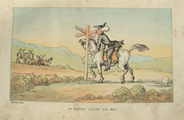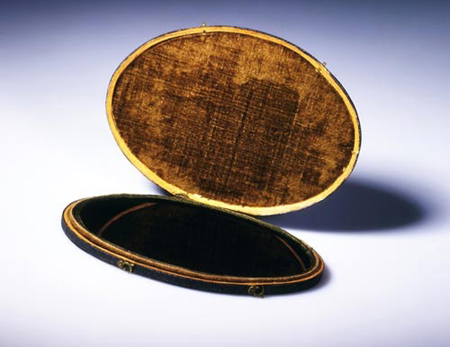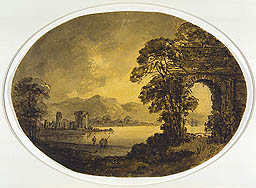The Emergence of Picturesque Tourism & Gray's 'Journal'
The Emergence of Picturesque Tourism
 The Picturesque movement was at the heart of the mid-eighteenth century discovery of the British landscape. Political instability in this period made travel to Europe difficult so the tourist, who would otherwise have embarked on the Grand Tour, turned his attention toward Britain in the hope that the relatively unexplored areas of the country would yield aesthetic experiences similar to those that were to be found on the Continent. As this quote from one of the earliest guide books - Thomas West's 'Guide to the Lakes' (1778) - illustrates, the Lake District was presented as a miniature version of the Alps: 'Those who intend to make the Continental tour should begin here; as it will give, in miniature, an idea of what they are to meet with there, in traversing the Alps' (p. 5). The tourist visiting the Lakes, West implies, could hope to encounter the awe and terror of Alpine sublime and the Picturesque scenes of rural Italy in a conveniently smaller geographical area.
The Picturesque movement was at the heart of the mid-eighteenth century discovery of the British landscape. Political instability in this period made travel to Europe difficult so the tourist, who would otherwise have embarked on the Grand Tour, turned his attention toward Britain in the hope that the relatively unexplored areas of the country would yield aesthetic experiences similar to those that were to be found on the Continent. As this quote from one of the earliest guide books - Thomas West's 'Guide to the Lakes' (1778) - illustrates, the Lake District was presented as a miniature version of the Alps: 'Those who intend to make the Continental tour should begin here; as it will give, in miniature, an idea of what they are to meet with there, in traversing the Alps' (p. 5). The tourist visiting the Lakes, West implies, could hope to encounter the awe and terror of Alpine sublime and the Picturesque scenes of rural Italy in a conveniently smaller geographical area.
Picturesque means 'like a picture' and, as Jonathan Bate notes in 'The Song of the Earth', 'the early tourists went armed with guidebook, sketchpad, Claude glass and sometimes camera obscura' (p. 127). The guidebook directed the tourist to the most Picturesque prospects, usually located on the shores of the larger lakes, and once there he would turn his back on the landscape, look at it reflected in the Claude Glass, and make a sketch or write a description.  This practice may seem strange and, indeed, it was lampooned at the time in the satirical cartoon 'Dr Syntax in Search of the Picturesque'. Yet, as Bate suggests, modern tourists have their own equivalent: 'When we see an especially fine view, we take a photograph of it. If we stop and think about the procedure, this is a rather strange thing to do' (p. 127).
This practice may seem strange and, indeed, it was lampooned at the time in the satirical cartoon 'Dr Syntax in Search of the Picturesque'. Yet, as Bate suggests, modern tourists have their own equivalent: 'When we see an especially fine view, we take a photograph of it. If we stop and think about the procedure, this is a rather strange thing to do' (p. 127).
For the Picturesque tourist, reducing the landscape to a picture was just one part of a larger process. The aim was not just to locate landscapes in Britain that were of equal value to the scenery found in Europe, it was also to respond to those landscapes using the appropriate aesthetic vocabulary. Such responses were dominated by references to the neo-classical paintings of Claude Lorrain, Salvator Rosa and Nicholas Poussin, and to the classical poetry of Horace and Virgil. As Malcolm Andrews notes, 'the tourist travelling through the Lakes will loudly acclaim the native beauties of British landscape by invoking idealized foreign models' (p. 3). Picturesque description was not an original response to natural scenery but rather developed out of pre-determined aesthetic values that the writer or painter imposed onto the landscape. Knowledge of high forms of art was a pre-requisite of the Picturesque and, as such, it appealed to a very specialised audience: the 'gentleman of taste' who was well versed in classical and neo-classical aesthetics.
Gray's 'Journal' and the Picturesque
 Gray clearly fits the profile of the Picturesque traveller - another enthusiast, William Gilpin, tellingly comments that 'no man was a greater admirer of nature, than Mr Gray; nor admired it with better taste' (p. vi) - and it is likely that he visited the Lake District with a pre-determined idea about how he should respond to the landscape. However, Gray's 'Journal' was composed at a time when the Picturesque was still very much in its infancy, existing only as an aesthetic category and not as a clearly delineated mode of tourism. The rage for the Lake District as a site of Picturesque tourism did not begin in earnest until the mid-to-late 1770s, some six years after Gray composed the 'Journal'. This timing is significant because, as an early example of writing on the Lake District, Gray's engagement with the landscape was not purely determined by Picturesque aesthetics. As William Ruddick argues:
Gray clearly fits the profile of the Picturesque traveller - another enthusiast, William Gilpin, tellingly comments that 'no man was a greater admirer of nature, than Mr Gray; nor admired it with better taste' (p. vi) - and it is likely that he visited the Lake District with a pre-determined idea about how he should respond to the landscape. However, Gray's 'Journal' was composed at a time when the Picturesque was still very much in its infancy, existing only as an aesthetic category and not as a clearly delineated mode of tourism. The rage for the Lake District as a site of Picturesque tourism did not begin in earnest until the mid-to-late 1770s, some six years after Gray composed the 'Journal'. This timing is significant because, as an early example of writing on the Lake District, Gray's engagement with the landscape was not purely determined by Picturesque aesthetics. As William Ruddick argues:
'He [Gray] was conditioned in relation to what he should seek out, and (to some extent) in his expectations concerning how he should respond by his predecessors in the area. But he should also be credited with having often taken an independent line in seeking out sublime and beautiful stimuli, and in the quickness with which he responded to unexpected opportunities or strokes of luck.' (p. 140)
Gray's ability to take an independent line and to react to factors which suddenly change the landscape is evident in his representation of the physical textures and noises he experiences, and in his remarkable eye for detail: 'the Darwent clear as glass, & shewing under its bridge every trout, that passes' (p. 1088). These individual touches create a highly intimate text that records a personalised experience of place, which is at odds with the distanced and formulaic responses of Picturesque writings. This difference is an important one because it shows that, at the time of the 'Journal''s composition, Gray's awareness of the Picturesque is not entirely determining his textual engagement with the landscape. He is still capable, as Norman Nicholson notes in 'The Lakers', of 'look[ing] about him, often with a clarity of vision for which he has not often been credited' (p. 48). This individual aspect of the 'Journal', and the rejection of Picturesque rules that it implies, might be attributed to the fact that Gray's response is poetic - in 'Guide to the Lakes', Wordsworth famously praises 'Gray, the Poet' for his 'distinctness and unaffected simplicity' (p. 207).

